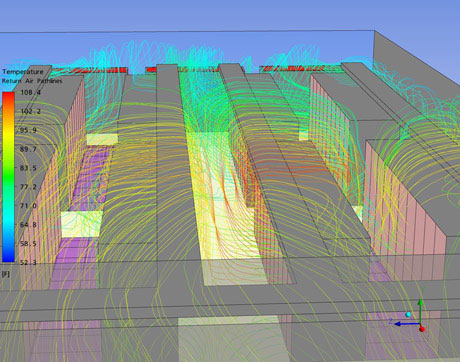Editor’s Pick: Software Optimizes Data Center Designs

CoolSim provides data center design engineers and operators a cloud- and subscription-based CFD (computational fluid dynamics) airflow modeling and design optimization tool. Image courtesy of Applied Math Modeling Inc.
Latest News
February 25, 2015
 Dear Desktop Engineering Reader:
Dear Desktop Engineering Reader:
 Data centers are wonderful things, of course. Unless you’re responsible for paying the electric bill to cool them. Then they’re scary expensive.
Data centers are wonderful things, of course. Unless you’re responsible for paying the electric bill to cool them. Then they’re scary expensive.
See, all those racks of high-speed, high-powered hardware with all them thar twinkling lights represent incredible amounts of horsepower that enable you to do incredible things. But they also represent an incredible source of heat. You have to lower that heat or the environment will become a blast oven that’ll slowly fry your hardware investment. And all that air conditioning is expensive — industry estimates are that anywhere from 50 to 75% of your data center energy budget goes toward powering its cooling systems. What to do? You might want to consider CoolSim from Applied Math Modeling Inc. The company just released version 4.4 of the software, so more on the new features in a bit.
The nickel tour of CoolSim is that it is a thermal modeling simulation tool focused solely on predicting the cooling performance and efficiency in data centers. CoolSim is a cloud-based engineering service, so you only subscribe to as much of it as you need to analyze and optimize the airflow in your data center. You can use it to understand and optimize your existing design or to analyze several possibilities for a new data center design.
As a cloud-based application, CoolSim appears to barely tax your workstation or your in-house HPC (high-performance computing) resources, unlike a local CFD (computational fluid dynamics) application. All you need to run it is a lightweight client application, a high-speed Internet connection and a Windows workstation about as modest as something you use at home to surf the Web. Two key details explain how CoolSim operates.
First, you use the client application to create the input information and build your data center thermal model in a drag-and-drop — i.e., non-threatening — interface. CoolSim helps you do this with a library of real-world components that you can plug into your model. You can add your own components, too. It also has tools that let you encapsulate your model’s specifications, evaluate airflow and thermal loads as well as check airflow rates and cooling capacity. You do this before you run your simulation, and all pre- and post-processing is unlimited, so you’re not watching a tab run up on a meter all the time.
Second, you submit your model for processing, and CoolSim leverages ANSYS Fluent CFD technology for meshing, solving and post-processing while you go off and attend to your day job. ANSYS Fluent supports parallel processing, meaning a single simulation can run with some alacrity. CoolSim also offers you the ability to run multiple concurrent simulations for design optimization sequences.
When your job is done, CoolSim sends you an HTML simulation report. Reports include performance analyses, thermal maps, 2D and 3D color contour plots, animations of temperature distribution and airflow patterns plus a wealth of additional data crucial to an informed decision-making process.
In CoolSim version 4.4, one key enhancement is that it sports a new model-building environment that lets you make your data center model using 2D and 3D views simultaneously. You can also use multiple display monitors for more on-screen real estate. Additionally, it has a new Ducting Tool for quickly incorporating and modeling ducted supply designs as well as ease of use features for modeling like object alignment and transparency.
You can read more about CoolSim 4.4 in today’s Pick of the Week write-up. You’ll find a bunch of links at the end of the main write-up that go to on-demand webinars and a library of technical white papers on data center thermal management simulations. Make sure to hit the video link to watch an overview (registration free) on CoolSim 4.4.
Your data center is key to your engineering success and corporate profitability. It is also a major source of non-value add expense. And, as the complexity of data centers increases, your expenses will likely rise. The CoolSim methodology sounds like a neat, convenient and powerful way to evaluate your data center designs as well as figure out the right spot for your current or new equipment, all with the aim of increasing cooling efficiency and reducing your overhead costs. Hit today’s Pick of the Week link to learn more about CoolSim 4.4. Good stuff.
Thanks, Pal. – Lockwood
Anthony J. Lockwood
Editor at Large, Desktop Engineering
Read today’s Pick of the Week write-up.
This is sponsored content. Click here to see how it works.
Subscribe to our FREE magazine, FREE email newsletters or both!
Latest News
About the Author
Anthony J. Lockwood is Digital Engineering’s founding editor. He is now retired. Contact him via [email protected].
Follow DE





